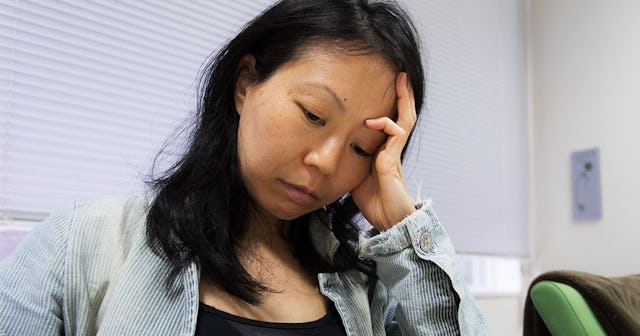It's Not You, It's Me: The Reality Of Loving Someone Who Lives With PTSD

I hear my daughter slamming something against her bedroom floor and freeze. My logical brain knows I’m not in immediate danger, but my hands shake, and my entire body go rigid. What’s wrong with me? Well, that’s a loaded question with an incredibly complex answer.
Here’s the thing: nothing is wrong with me, I just live with Post Traumatic Stress Disorder (PTSD), and yes, it impacts my everyday life. Truthfully, it’s emotionally exhausting to explain my abnormal and magnified reaction to otherwise regular things. But hey, I’m gonna take one for the team and give you a glimpse into my world.
Before continuing, let’s get something straight. No one owes anyone an explanation about their trauma, reactions, or how they choose to manage their condition. I choose to share my experience because I hope it helps someone, somewhere out there. Whether you’re the person living with PTSD or you’re the person who is loving someone, communicating about the reality of living with this condition helps us all. Big group hug — now let’s dive in.
The phrase, it’s not you, it’s me, has never felt more fitting when sharing my experience. Feeling withdrawn and triggered by otherwise mundane events literally has nothing to do with the person I’m with when it’s happening. So, allow me to share a few things you might not have known about being in a relationship with someone who lives with PTSD.
PTSD Can Happen To Anyone
Mainstream media hasn’t done a stellar job (in my opinion) representing PTSD. It isn’t reserved only for heroes coming home from war, firefighters, police officers, or other occupations where traumatic events are practically guaranteed.
Yes, some of these folks will definitely live with PTSD. But what mainstream culture doesn’t represent is the reality that 1 in 11 people will be diagnosed with PTSD in their lifetime, according to the American Psychiatric Association.
Take the first 11 people who come to mind that you personally know. Are they all people in trauma-related occupations? Likely, they aren’t. They are teachers and stay-at-home-moms. They are college students and nail techs. They are people who show up at work every day like nothing is amiss, but underneath a carefully crafted facade, they are that 1 in 11. Unfortunately, that stat only accounts for people who are diagnosed, not the rest of us (raises hand) who have lived with PTSD and have never known it.
I am an example of the 1 in 11 who hasn’t done anything extraordinary in life. I haven’t been kidnapped or been trapped in a burning building. Fireworks don’t invoke flashbacks of gunfire whizzing past my ear. Nope. I’m just an ordinary person, living an ordinary life, who has lived through life-changing events.
Something else important to know about PTSD is that it might not come on directly after a traumatic event. It could emerge a month, a year, or many years since the trauma initially occurred. Mine stems from events in my life that I didn’t even realize were traumatic at the time. I mean, I knew things weren’t peachy-keen, but I couldn’t pinpoint what was wrong with them.
These events weren’t just one-off occurrences. Everything culminated into a whole messy made-for-the-movies kind of situation that actually took root 12 years before my diagnosis. Loud noises are a trigger for me. It’s not the fireworks that bother me or a car backfiring. It’s raised voices.
So yeah, you might just be on the phone yelling at the AT&T guy for not fixing the phone bill for the umpzillionth time (which is never gonna happen), but my body and my ears recognize a raised voice as something that used to happen right before trauma ensued. It’s not you yelling (at me), it’s my body that doesn’t recognize the difference. My body thinks I’m still in a dangerous situation, as opposed to just a really fucking annoying one.
How Do You Live With PTSD?
There is no right or wrong way to do this. My only ask is you give yourself permission to live your best life despite your trauma. Maybe it means confiding in a dear friend. Or maybe it means seeing a therapist and managing with medication. Go on with your bad self and do whatever you need to do to live a quality of life you are happy with.
Self-care is for everyone, but for those living with PTSD, it’s definitely a non-negotiable. Bubbles baths and pedicures are great, but there’s a lot more to self-care than just that. Self-care can be as simple as saying no to situations that trigger anxiety or flashbacks. If there are moments where your reaction is over the top, or you feel like you’re in fight-or-flight mode for no apparent reason, it isn’t selfish to take a step back to figure out why. SELF-CARE ISN’T SELFISH. I had to put that in caps, because well, I need to make sure you hear me loud and clear — there is nothing selfish about self-care.
It can be hard to advocate for yourself and say, I need some time. That’s where the people in your life who love you come into play. Don’t be afraid to lean on the people who love you. Likewise, if you are in a relationship with someone who struggles with PTSD, don’t be afraid to communicate your support for them. Having a conversation about what their triggers are or how you can help them engage in self-care will be a game-changer for both of you.
As it is with any relationship, communication and understanding for on another is what makes the world go round. I can guarantee is it won’t always be easy, because I have lived it. But on that same note I can also guarantee it will always be worth it. Because you are worth it, and you deserve to be loved.
This article was originally published on